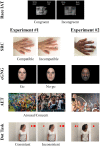Relationships between the race implicit association test and other measures of implicit and explicit social cognition
- PMID: 37575432
- PMCID: PMC10415041
- DOI: 10.3389/fpsyg.2023.1197298
Relationships between the race implicit association test and other measures of implicit and explicit social cognition
Abstract
Background: The race-based Implicit Association Test (IAT) was proposed to measure individual differences in implicit racial bias subsumed within social cognition. In recent years, researchers have debated the theoretical tenets underpinning the IAT, questioning whether performance on this task: (1) measures implicit attitudes that operate automatically outside of conscious awareness; (2) reflects individual differences in social cognition; and (3) can predict social behavior. One way to better address these research questions is to assess whether the race-IAT correlates with other implicit processes that are subsumed within social cognition.
Aims: The current study assessed whether the race-IAT was related to other commonly used individual difference measures of implicit (and explicit) social cognition. Experiment 1 assessed whether dissociable patterns of performance on the race-IAT were related to measures of implicit imitative tendencies, emotion recognition and perspective taking toward White task actors, as well as explicit measures of trait and state affective empathy and racial bias. Overcoming limitations of task conceptual correspondence, Experiment 2 assessed whether these latter tasks were sensitive in detecting racial biases by using both White and Black task actors and again examined their relationships with the race-IAT.
Method: In two lab-based experiments, 226 and 237 participants completed the race-IAT followed by an extensive battery of social cognition measures.
Results: Across both experiments, pro-White/anti-Black bias on the race-IAT was positively related to a pro-White bias on explicit measures of positive affective empathy. However, relationships between the race-IAT and implicit imitative tendencies, perspective taking, emotion recognition, and explicit trait and negative state affective empathy were statistically equivalent.
Conclusion: The race-IAT was consistently related to explicit measures of positive state affective empathy but not to other individual difference measures of implicit social cognition. These findings are discussed with regards to the theoretical underpinnings of the race-IAT as an individual difference measure of implicit social cognition, as well as alternative explanations relating to the reliability of social cognition measures and the various combinations of general-purpose (social and non-social) executive processes that underpin performance on these tasks.
Keywords: implicit measures; individual differences; race IAT; race implicit association test; social cognition; theory.
Copyright © 2023 Pennington, Ploszajski, Mistry, NgOmbe, Back, Parsons and Shaw.
Conflict of interest statement
The authors declare that the research was conducted in the absence of any commercial or financial relationships that could be construed as a potential conflict of interest.
Figures


Similar articles
-
The target/perpetrator brief-implicit association test (B-IAT): an implicit instrument for efficiently measuring discrimination based on race/ethnicity, sex, gender identity, sexual orientation, weight, and age.BMC Public Health. 2021 Jan 19;21(1):158. doi: 10.1186/s12889-021-10171-7. BMC Public Health. 2021. PMID: 33468085 Free PMC article.
-
Exploring the Effect of Cooperation in Reducing Implicit Racial Bias and Its Relationship With Dispositional Empathy and Political Attitudes.Front Psychol. 2020 Oct 28;11:510787. doi: 10.3389/fpsyg.2020.510787. eCollection 2020. Front Psychol. 2020. PMID: 33192759 Free PMC article.
-
Estimating implicit and explicit racial and ethnic bias among community pharmacists in Canada.Saudi Pharm J. 2024 May;32(5):102024. doi: 10.1016/j.jsps.2024.102024. Epub 2024 Mar 11. Saudi Pharm J. 2024. PMID: 38525267 Free PMC article.
-
The Implicit Association Test: A Method in Search of a Construct.Perspect Psychol Sci. 2021 Mar;16(2):396-414. doi: 10.1177/1745691619863798. Epub 2019 Oct 24. Perspect Psychol Sci. 2021. PMID: 31647752 Review.
-
Predicting Behavior With Implicit Measures: Disillusioning Findings, Reasonable Explanations, and Sophisticated Solutions.Front Psychol. 2019 Nov 8;10:2483. doi: 10.3389/fpsyg.2019.02483. eCollection 2019. Front Psychol. 2019. PMID: 31787912 Free PMC article. Review.
Cited by
-
Are we capturing individual differences? Evaluating the test-retest reliability of experimental tasks used to measure social cognitive abilities.Behav Res Methods. 2025 Jan 31;57(2):82. doi: 10.3758/s13428-025-02606-5. Behav Res Methods. 2025. PMID: 39890691 Free PMC article.
-
Test-retest reliability for common tasks in vision science.J Vis. 2022 Jul 11;22(8):18. doi: 10.1167/jov.22.8.18. J Vis. 2022. PMID: 35904797 Free PMC article.
References
-
- Atewologun D., Cornish T., Tresh F. (2018) Unconscious bias training: An assessment of the evidence for effectiveness. Equality & Human Rights Commission. Available at: https://www.equalityhumanrights.com/en/publication-download/unconscious-... (Accessed July 18, 2023).
-
- Batson C. D., Ahmad N. Y. (2009). Using empathy to improve intergroup attitudes and relations. Soc. Issues Policy Rev. 3, 141–177. doi: 10.1111/j.1751-2409.2009.01013.x - DOI
LinkOut - more resources
Full Text Sources
Miscellaneous

